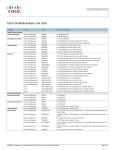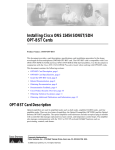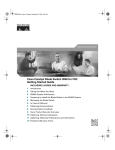Download Cisco Expansion Module 7914 Specifications
Transcript
Phone Guide Cisco IP Phone Expansion Module 7914 INCLUDING LICENSE AND WARRANTY 1 Introducing the Cisco IP Phone Expansion Module 7914 2 Installing the Expansion Module 7914 3 Features of the Expansion Module 7914 4 Using the Expansion Module 7914 5 Troubleshooting the Expansion Module 7914 6 Technical Specifications for the Expansion Module 7914 7 Where to Find More Information 8 Cisco Product Security Overview 9 Obtaining Technical Assistance 10 Cisco One-Year Limited Hardware Warranty Terms 1 Introducing the Cisco IP Phone Expansion Module 7914 The Cisco IP Phone Expansion Module 7914 attaches to your Cisco IP Phone, adding 14 extra line appearances or programmable buttons to your phone. Attaching a second Expansion Module to your Cisco IP Phone adds a total of 28 extra line appearances or programmable buttons to your phone. The programmable buttons can be configured for speed dial numbers or to access phone services. Note Cisco IP Phone 7960G with 2 Expansion Modules 120043 Figure 1 For the latest information about supported phone models, contact your system administrator. Before You Begin Before you begin installing your Expansion Module 7914, read each of these sections: • Package Contents, page 3 • Footstand Kits, page 3 2 • Additional Equipment, page 3 • Safety Information, page 4 Package Contents Make sure that your package includes the following items: • One Cisco IP Phone Expansion Module 7914 • One interface cable • This Cisco IP Phone Expansion Module 7914 Phone Guide Footstand Kits In addition to the items in the package, you also need a Footstand Kit (separate orderable item). If you are attaching one Expansion Module 7914, you need the single Footstand Kit. If you are attaching two Expansion Module 7914s, you need the double Footstand Kit. The Footstand Kit contains: • One support bar (single with one thumbscrew, or double with two thumbscrews) • One footstand Additional Equipment You also need the following equipment. • Small flat head screwdriver—for use during the installation • Power supply unit—depending on how many Expansion Modules you are installing and how your Cisco IP Phone is powered, you will require power supply unit(s) as follows: Power over the Ethernet to your Cisco IP Phone With one or two Expansion Modules, you need a power supply unit (separate orderable item). 3 Power supply to your Cisco IP Phone With one Expansion Module, you do not need a power supply unit. With two Expansion Modules, you need a power supply unit (separate orderable item). Note Use of a non-Cisco certified power supply unit might not work and voids the Expansion Module 7914 product warranty. Safety Information The following safety warnings are for the Expansion Module 7914. Read these notices before you install or use the Expansion Module 7914. For translated warnings, refer to the Regulatory Compliance and Safety Information for the Cisco IP Phone 7900 Series. Installing and Using Your Expansion Module 7914 Read the following safety notices before installing or using your Expansion Module 7914: Warning IMPORTANT SAFETY INSTRUCTIONS This warning symbol means danger. You are in a situation that could cause bodily injury. Before you work on any equipment, be aware of the hazards involved with electrical circuitry and be familiar with standard practices for preventing accidents. Use the statement number provided at the end of each warning to locate its translation in the translated safety warnings that accompanied this device. SAVE THESE INSTRUCTIONS Warning 4 Read the installation instructions before you connect the system to its power source. Warning Ultimate disposal of this product should be handled according to all national laws and regulations. Warning Do not work on the system or connect or disconnect cables during periods of lightning activity. Warning To avoid electric shock, do not connect safety extra low voltage (SELV) circuits to telephone network voltage (TNV) circuits. LAN ports contain SELV circuits, and WAN ports contain TNV circuits. Some LAN and WAN ports use RJ-45 connectors. Use caution when connecting cables. Using an External Power Supply The following warnings apply when you use the external power supply with the Expansion Module 7914: Warning This product relies on the building's installation for short-circuit (over current) protection. Ensure that a fuse or circuit breaker no larger than 120 VAC, 15A U.S. (240 VAC, 10A international) is used on the phase conductors (all current-carrying conductors). Warning The device is designed to work with TN power systems. Warning The plug-socket combination must be accessible at all times because it serves as the main disconnecting device. 5 Warning The power supply must be placed indoors. Caution Only use the specified Cisco-approved power supply on this product. 2 Installing the Expansion Module 7914 Note To ensure a successful installation of the Expansion Module 7914, make sure you have read the entire “Before You Begin” section on page 2. To install the Expansion Module 7914, perform the following steps. 1. Remove the Footstand from the Cisco IP Phone. 2. Connect the Support Bar to the Cisco IP Phone. 3. Connect the Expansion Module 7914 to the Support Bar. 4. Connect the Interface Cable. 5. Connect the Power Supply. 6. Connect the Footstand. 7. Connect a Laptop Cable Lock (optional). Refer to the detailed instructions and corresponding illustrations that follow for each of these high-level steps. Caution 6 To ensure a successful installation, verify with your system administrator that your phone is ready for the Expansion Module 7914 and that Cisco CallManager is installed and configured for the Expansion Module 7914. Make sure that you have all of the parts that you need (see the “Before You Begin” section on page 2). Remove the Footstand from the Cisco IP Phone Refer to Figure 2 and the steps that follow. Removing the Footstand 63147 Figure 2 Step 1 Unplug the Cisco IP Phone network and power connections. Step 2 Unplug the handset, and unplug the headset if one is attached to the phone. Step 3 Turn the Cisco IP Phone over and lay it on a protected flat surface to prevent it from being scratched. Step 4 Locate the two foot pins on the footstand. 7 Step 5 Use a flat head screwdriver to carefully push on one of the foot pins to release it. Then carefully push on the other foot pin to release it. Note Step 6 You may have to lift and hold the Cisco IP Phone to support it when pushing the foot pins. When pushing on the footpins, push away from your body. Lift off the footstand and store it separately. Connect the Support Bar to the Cisco IP Phone Refer to Figure 3 and the steps that follow. Connecting the Support Bar 140969 140969 Figure 3 Step 1 Position the support bar on the back of the Cisco IP Phone so that it fits flush with the phone. Step 2 Locate the two connector pins. Step 3 Use a flat head screwdriver to carefully push each of the connector pins so that the support bar is firmly fastened to the Cisco IP Phone. 8 Connect the Expansion Module 7914 to the Support Bar Refer to Figure 4 and the steps that follow. Figure 4 Connecting the Expansion Module 1 Open slots on the Expansion Module 7914 2 Hooks on the support bar 3 Thumbscrews 9 Step 1 Position the phone so that the front of the phone is facing up. Step 2 Line up the two open slots on the bottom of the Expansion Module 7914 with the two hooks on the support bar. Step 3 Insert the hooks into the slots and then rotate the top of the Expansion Module 7914 into the support bar so that it rests flush with the bar. Step 4 Tighten the thumbscrew on the back of the Expansion Module 7914. Note If you are installing two Expansion Modules, repeat Steps 2, 3, and 4 for the second Expansion Module. Connect the Interface Cable Refer to the following table, which depicts the “in” and “out” icons on the AUX jacks, and to Figure 5 and the steps that follow. In icon Note 10 Out icon On your Cisco IP Phone or Expansion Module 7914, the AUX jack may be labelled RS-232. In this case read “RS-232 jack” for AUX jack in Figure 5 and Steps 1 – 4 in this section. 140166 Connecting the Interface Cable 140966 Figure 5 2 4 3 1 1 Interface cable connection to the AUX jack on the Cisco IP Phone 2 Interface cable connection to the AUX jack labeled with the “in” icon on Expansion Module 1 3 Second interface cable connection to the AUX jack labeled with the “out” icon on Expansion Module 1 4 Second interface cable connection to the AUX jack labeled with the “in” icon on Expansion Module 2 Step 1 Plug one end of the interface cable into the jack labeled AUX on the Cisco IP Phone. Step 2 Plug the other end of the interface cable into the AUX jack with the “in” icon underneath on the Expansion Module 7914. Note If you are installing a second Expansion Module 7914, continue with Steps 3 and 4. Otherwise go to the “Connect the Power Supply” section on page 12. 11 Step 3 Plug one end of the second interface cable into the AUX jack with the “out” icon underneath on the first Expansion Module (the one closest to the phone). Step 4 Plug the other end of the second interface cable into the AUX jack with the “in” icon underneath on the second Expansion Module (the one next to the first Expansion Module). Connect the Power Supply Refer to Figure 6 and the steps that follow. Figure 6 1 12 Connecting the Power Supply Power supply connector on the back of the Expansion Module Step 1 Depending on how your Cisco IP Phone is powered with one or two Expansion Modules, perform one of the following actions to connect the power supply: • Your Cisco IP Phone is powered over the Ethernet with one Expansion Module: – connect the power supply unit to the AC adapter port on the Expansion Module and plug the other end into a standard electrical power outlet in the wall. • If your Cisco IP Phone is powered over the Ethernet with two Expansion Modules: – connect the power supply unit to the AC adapter port on the Expansion Module closest to the Cisco IP Phone and plug the other end into a standard electrical power outlet in the wall. • If your Cisco IP Phone is powered with a power supply unit with one Expansion Module: – reconnect the original Cisco IP Phone power supply unit to the AC adapter port on the Cisco IP Phone and plug the other end into a standard electrical power outlet in the wall. • If your Cisco IP Phone is powered with a power supply unit with two Expansion Modules: – connect a second power supply unit to the AC adapter port on the Expansion Module closest to the Cisco IP Phone and plug the other end into a standard electrical power outlet in the wall. Step 2 Reconnect the Cisco IP Phone handset and network connection. 13 Connect the Footstand Refer to Figure 7 and the steps that follow. Figure 7 Connecting the Footstand 2 1 Slots on the support bar 2 Hooks on the footstand 140968 1 Step 1 Locate the three hooks on the footstand. Step 2 Position the hooks so that they align with the open slots on the support bar. Note Step 3 14 There are four positions in each of the three sets of open slots on the support bar. This lets you choose the angle of the footstand. Insert the footstand hooks into the support bar and push in slightly to make the connection. Connect a Laptop Cable Lock (optional) Note Supported only on phones that have a security slot on the back of the phone. Contact your system administrator for more information. Refer to Figure 8 and the steps that follow. Connecting a Laptop Cable Lock 140967 140967 Figure 8 Step 1 Detach the cable lock door from the support bar. Step 2 Secure the security cable to a desktop. Step 3 Insert the laptop cable lock into the security slot on the back of the phone, lock it, and remove the key. 15 Start Up Sequence After the Expansion Module 7914 is installed, upon startup the buttons all show a steady red light. Then the LCD screen refreshes and the buttons all go off and any line appearances are displayed in the LCD screen. You can then start using the Expansion Module. 3 Features of the Expansion Module 7914 The Expansion Module 7914 includes the following features. 1 16 Phone screen—Displays the phone number, speed dial number (or name or other text label), phone service, or Privacy assigned to each button. Icons indicating line status appear similar to, and function the same as, those on the Cisco IP Phone to which it is attached. 2 Lighted Buttons—14 buttons. Each button corresponds to one line (just like on the Cisco IP Phone). The lights beneath each button indicate the state of the corresponding line as follows: Line available: light off Line in use by you: steady green light Line in use by someone else: steady red light Line ringing: flashing amber light You have a call on hold: flashing green light Someone else has a call on hold: flashing red light Call transfer: steady green light 4 Using the Expansion Module 7914 The Expansion Module 7914 functions as a line appearance or programmable button module, allowing you to keep track of calls in progress, calls on hold, and calls requiring transfer, or to access phone services. All call functions, such as answering a call, placing a call on hold, transferring a call, and so on, are performed from the Cisco IP Phone. Refer to the phone guide for your Cisco IP Phone for instructions about using your phone. Here is a typical scenario when using the Cisco IP Phone and Expansion Module 7914 combination. You receive a call for your Director at extension 12345. You look at your Expansion Module 7914 and see that your Director has a call in progress with another party and also has another call on hold. Looking down the Expansion Module 7914 screen, you note that another manager in your group has just completed a call and could possibly assist the incoming caller. You consult briefly with the incoming caller and then transfer the call to the manager. 17 Keeping Your Call Information Private If Privacy is programmed for one of your buttons, you can keep your call information private from users who share your lines. If you see a button labeled “Privacy,” then this feature has been enabled for you by your system administrator. You toggle privacy on and off by pressing the Privacy button when receiving an incoming call. In addition, with Privacy enabled, other shared lines are blocked from joining your calls. Refer to the phone guide for your Cisco IP Phone for more information. Configuring the Buttons on Your Expansion Module 7914 Similar to your Cisco IP Phone, you can configure speed dial numbers or program buttons to access phone services on the Expansion Module 7914. Before you can do this, ask your system administrator for the following information to access your Cisco IP Phone User Options web page: • the URL • your user name and password After you have this information, you can configure your speed dial numbers or program buttons to access phone services. Phone services can include, for example, weather, stock quotes, or corporate calendars and directories. Refer to the phone guide for your Cisco IP Phone for more information. Adjusting the Contrast Similar to your Cisco IP Phone, you can adjust the contrast on the Expansion Module 7914. Refer to the phone guide for your Cisco IP Phone for more information. 18 5 Troubleshooting the Expansion Module 7914 The following table might help you if you are having difficulty using your Expansion Module 7914. Problem No display on the Expansion Module 7914. Solution • Verify that all of the cable connections are correct. • Verify that you have power to the Expansion Module 7914(s). Buttons on the first Expansion Module 7914 are all red. Verify with your system administrator that your Expansion Module 7914 is defined in Cisco CallManager. Buttons on the second Expansion Module 7914 are all amber. Verify with your system administrator that your Expansion Module 7914 is defined in Cisco CallManager. If you are experiencing other difficulties, contact your system administrator. 6 Technical Specifications for the Expansion Module 7914 This section provides the physical and operating environment specifications for the Cisco IP Phone Expansion Module 7914, as well as the regulatory compliance information. 19 Physical and Operating Environment Specifications Specification Value or Range Operating Temperature 32 to 104°F (0 to 40°C) Operating relative humidity 10 to 95% (noncondensing) Storage temperature 14 to 140°F (-10 to 60°C ) Height 203 mm, 8.0 in. Width 121 mm, 4.75 in. Depth 51 mm, 2.0 in. Weight 366 g, 0.82 lb. Power 48 VDC, 40mA max Cable Specifications • 2 RJ-11 jacks with 6-pin connectors for the interface cable connections • 48-V power connector. The diameter of the center pin in the Expansion Module power jack (Switchcraft 712A) is 0.1 in. (2.5 mm). The center pin is positive (+) voltage. The miniature power plug required to mate with the power jack on the Expansion Module is a Switchcraft 760 or equivalent. 20 7 Where to Find More Information The following sections provide sources for obtaining additional documentation from Cisco Systems. Related Documentation The following documents provide additional information. • Cisco IP Phone Administration Guide for Cisco CallManager—Provides instructions for the system administrator about configuring the Expansion Module 7914 in Cisco CallManager. http://www.cisco.com/univercd/cc/td/doc/product/voice/ c_ipphon/index.htm • Phone guide for your Cisco IP Phone—Provides instructions for using the Cisco IP Phone. http://www.cisco.com/univercd/cc/td/doc/product/voice/ c_ipphon/index.htm • Cisco CallManager documentation—Provides instructions for using the Cisco CallManager Administration application to configure Cisco IP Phones and services. http://www.cisco.com/univercd/cc/td/doc/product/voice/ c_callmg/index.htm Obtaining Documentation Cisco documentation and additional literature are available on Cisco.com. Cisco also provides several ways to obtain technical assistance and other technical resources. These sections explain how to obtain technical information from Cisco Systems. Cisco.com You can access the most current Cisco documentation at this URL: http://www.cisco.com/techsupport 21 You can access the Cisco website at this URL: http://www.cisco.com You can access international Cisco websites at this URL: http://www.cisco.com/public/countries_languages.shtml Product Documentation DVD Cisco documentation and additional literature are available in the Product Documentation DVD package, which may have shipped with your product. The Product Documentation DVD is updated regularly and may be more current than printed documentation. The Product Documentation DVD is a comprehensive library of technical product documentation on portable media. The DVD enables you to access multiple versions of hardware and software installation, configuration, and command guides for Cisco products and to view technical documentation in HTML. With the DVD, you have access to the same documentation that is found on the Cisco website without being connected to the Internet. Certain products also have .pdf versions of the documentation available. The Product Documentation DVD is available as a single unit or as a subscription. Registered Cisco.com users (Cisco direct customers) can order a Product Documentation DVD (product number DOC-DOCDVD=) from Cisco Marketplace at this URL: http://www.cisco.com/go/marketplace/ Ordering Documentation Beginning June 30, 2005, registered Cisco.com users may order Cisco documentation at the Product Documentation Store in the Cisco Marketplace at this URL: http://www.cisco.com/go/marketplace/ Nonregistered Cisco.com users can order technical documentation from 8:00 a.m. to 5:00 p.m. (0800 to 1700) PDT by calling 1 866 463-3487 in the United States and Canada, or elsewhere by calling 011 408 519-5055. You can also order documentation by e-mail at 22 [email protected] or by fax at 1 408 519-5001 in the United States and Canada, or elsewhere at 011 408 519-5001. Documentation Feedback You can rate and provide feedback about Cisco technical documents by completing the online feedback form that appears with the technical documents on Cisco.com. You can send comments about Cisco documentation to [email protected]. You can submit comments by using the response card (if present) behind the front cover of your document or by writing to the following address: Cisco Systems Attn: Customer Document Ordering 170 West Tasman Drive San Jose, CA 95134-9883 We appreciate your comments. Obtaining Additional Publications and Information Information about Cisco products, technologies, and network solutions is available from various online and printed sources. • Cisco Marketplace provides a variety of Cisco books, reference guides, documentation, and logo merchandise. Visit Cisco Marketplace, the company store, at this URL: http://www.cisco.com/go/marketplace/ • Cisco Press publishes a wide range of general networking, training and certification titles. Both new and experienced users will benefit from these publications. For current Cisco Press titles and other information, go to Cisco Press at this URL: http://www.ciscopress.com 23 • Packet magazine is the Cisco Systems technical user magazine for maximizing Internet and networking investments. Each quarter, Packet delivers coverage of the latest industry trends, technology breakthroughs, and Cisco products and solutions, as well as network deployment and troubleshooting tips, configuration examples, customer case studies, certification and training information, and links to scores of in-depth online resources. You can access Packet magazine at this URL: http://www.cisco.com/packet • iQ Magazine is the quarterly publication from Cisco Systems designed to help growing companies learn how they can use technology to increase revenue, streamline their business, and expand services. The publication identifies the challenges facing these companies and the technologies to help solve them, using real-world case studies and business strategies to help readers make sound technology investment decisions. You can access iQ Magazine at this URL: http://www.cisco.com/go/iqmagazine or view the digital edition at this URL: http://ciscoiq.texterity.com/ciscoiq/sample/ • Internet Protocol Journal is a quarterly journal published by Cisco Systems for engineering professionals involved in designing, developing, and operating public and private internets and intranets. You can access the Internet Protocol Journal at this URL: http://www.cisco.com/ipj • Networking products offered by Cisco Systems, as well as customer support services, can be obtained at this URL: http://www.cisco.com/en/US/products/index.html 24 • Networking Professionals Connection is an interactive website for networking professionals to share questions, suggestions, and information about networking products and technologies with Cisco experts and other networking professionals. Join a discussion at this URL: http://www.cisco.com/discuss/networking • World-class networking training is available from Cisco. You can view current offerings at this URL: http://www.cisco.com/en/US/learning/index.html 8 Cisco Product Security Overview Cisco provides a free online Security Vulnerability Policy portal at this URL: http://www.cisco.com/en/US/products/products_security_vulne rability_policy.html From this site, you can perform these tasks: • Report security vulnerabilities in Cisco products. • Obtain assistance with security incidents that involve Cisco products. • Register to receive security information from Cisco. A current list of security advisories and notices for Cisco products is available at this URL: http://www.cisco.com/go/psirt If you prefer to see advisories and notices as they are updated in real time, you can access a Product Security Incident Response Team Really Simple Syndication (PSIRT RSS) feed from this URL: http://www.cisco.com/en/US/products/products_psirt_rss_feed. html 25 Reporting Security Problems in Cisco Products Cisco is committed to delivering secure products. We test our products internally before we release them, and we strive to correct all vulnerabilities quickly. If you think that you might have identified a vulnerability in a Cisco product, contact PSIRT: • Emergencies — [email protected] An emergency is either a condition in which a system is under active attack or a condition for which a severe and urgent security vulnerability should be reported. All other conditions are considered nonemergencies. • Nonemergencies — [email protected] In an emergency, you can also reach PSIRT by telephone: • 1 877 228-7302 • 1 408 525-6532 Tip We encourage you to use Pretty Good Privacy (PGP) or a compatible product to encrypt any sensitive information that you send to Cisco. PSIRT can work from encrypted information that is compatible with PGP versions 2.x through 8.x. Never use a revoked or an expired encryption key. The correct public key to use in your correspondence with PSIRT is the one linked in the Contact Summary section of the Security Vulnerability Policy page at this URL: http://www.cisco.com/en/US/products/products_securi ty_vulnerability_policy.html The link on this page has the current PGP key ID in use. 9 Obtaining Technical Assistance Cisco Technical Support provides 24-hour-a-day award-winning technical assistance. The Cisco Technical Support & Documentation website on Cisco.com features extensive online support resources. In addition, if you have a 26 valid Cisco service contract, Cisco Technical Assistance Center (TAC) engineers provide telephone support. If you do not have a valid Cisco service contract, contact your reseller. Cisco Technical Support & Documentation Website The Cisco Technical Support & Documentation website provides online documents and tools for troubleshooting and resolving technical issues with Cisco products and technologies. The website is available 24 hours a day, at this URL: http://www.cisco.com/techsupport Access to all tools on the Cisco Technical Support & Documentation website requires a Cisco.com user ID and password. If you have a valid service contract but do not have a user ID or password, you can register at this URL: http://tools.cisco.com/RPF/register/register.do Note Use the Cisco Product Identification (CPI) tool to locate your product serial number before submitting a web or phone request for service. You can access the CPI tool from the Cisco Technical Support & Documentation website by clicking the Tools & Resources link under Documentation & Tools. Choose Cisco Product Identification Tool from the Alphabetical Index drop-down list, or click the Cisco Product Identification Tool link under Alerts & RMAs. The CPI tool offers three search options: by product ID or model name; by tree view; or for certain products, by copying and pasting show command output. Search results show an illustration of your product with the serial number label location highlighted. Locate the serial number label on your product and record the information before placing a service call. 27 Submitting a Service Request Using the online TAC Service Request Tool is the fastest way to open S3 and S4 service requests. (S3 and S4 service requests are those in which your network is minimally impaired or for which you require product information.) After you describe your situation, the TAC Service Request Tool provides recommended solutions. If your issue is not resolved using the recommended resources, your service request is assigned to a Cisco TAC engineer. The TAC Service Request Tool is located at this URL: http://www.cisco.com/techsupport/servicerequest For S1 or S2 service requests or if you do not have Internet access, contact the Cisco TAC by telephone. (S1 or S2 service requests are those in which your production network is down or severely degraded.) Cisco TAC engineers are assigned immediately to S1 and S2 service requests to help keep your business operations running smoothly. To open a service request by telephone, use one of the following numbers: Asia-Pacific: +61 2 8446 7411 (Australia: 1 800 805 227) EMEA: +32 2 704 55 55 USA: 1 800 553-2447 For a complete list of Cisco TAC contacts, go to this URL: http://www.cisco.com/techsupport/contacts Definitions of Service Request Severity To ensure that all service requests are reported in a standard format, Cisco has established severity definitions. Severity 1 (S1)—Your network is “down,” or there is a critical impact to your business operations. You and Cisco will commit all necessary resources around the clock to resolve the situation. Severity 2 (S2)—Operation of an existing network is severely degraded, or significant aspects of your business operation are negatively affected by inadequate performance of Cisco products. You and Cisco will commit full-time resources during normal business hours to resolve the situation. 28 Severity 3 (S3)—Operational performance of your network is impaired, but most business operations remain functional. You and Cisco will commit resources during normal business hours to restore service to satisfactory levels. Severity 4 (S4)—You require information or assistance with Cisco product capabilities, installation, or configuration. There is little or no effect on your business operations. 10 Cisco One-Year Limited Hardware Warranty Terms There are special terms applicable to your hardware warranty and various services that you can use during the warranty period. Your formal Warranty Statement, including the warranties and license agreements applicable to Cisco software, is available on Cisco.com. Follow these steps to access and download the Cisco Information Packet and your warranty and license agreements from Cisco.com. 1. Launch your browser, and go to this URL: http://www.cisco.com/univercd/cc/td/doc/es_inpck/cetrans. htm The Warranties and License Agreements page appears. 2. To read the Cisco Information Packet, follow these steps: a. Click the Information Packet Number field, and make sure that the part number 78-5235-03A0 is highlighted. b. Select the language in which you would like to read the document. c. Click Go. The Cisco Limited Warranty and Software License page from the Information Packet appears. d. Read the document online, or click the PDF icon to download and print the document in Adobe Portable Document Format (PDF). 29 Note You must have Adobe Acrobat Reader to view and print PDF files. You can download the reader from Adobe’s website: http://www.adobe.com 3. To read translated and localized warranty information about your product, follow these steps: a. Enter this part number in the Warranty Document Number field: 78-10747-01C0 b. Select the language in which you would like to view the document. c. Click Go. The Cisco warranty page appears. d. Read the document online, or click the PDF icon to download and print the document in Adobe Portable Document Format (PDF). You can also contact the Cisco service and support website for assistance: http://www.cisco.com/public/Support_root.shtml. Duration of Hardware Warranty One (1) Year Replacement, Repair, or Refund Policy for Hardware Cisco or its service center will use commercially reasonable efforts to ship a replacement part within ten (10) working days after receipt of a Return Materials Authorization (RMA) request. Actual delivery times can vary, depending on the customer location. Cisco reserves the right to refund the purchase price as its exclusive warranty remedy. 30 To Receive a Return Materials Authorization (RMA) Number Contact the company from whom you purchased the product. If you purchased the product directly from Cisco, contact your Cisco Sales and Service Representative. Complete the information below, and keep it for reference. Company product purchased from Company telephone number Product model number Product serial number Maintenance contract number 31 Corporate Headquarters Cisco Systems, Inc. 170 West Tasman Drive San Jose, CA 95134-1706 USA www.cisco.com Tel: 408 526-4000 800 553-NETS (6387) Fax: 408 526-4100 European Headquarters Cisco Systems International BV Haarlerbergpark Haarlerbergweg 13-19 1101 CH Amsterdam The Netherlands www-europe.cisco.com Tel: 31 0 20 357 1000 Fax: 31 0 20 357 1100 Americas Headquarters Cisco Systems, Inc. 170 West Tasman Drive San Jose, CA 95134-1706 USA www.cisco.com Tel: 408 526-7660 Fax: 408 527-0883 Asia Pacific Headquarters Cisco Systems, Inc. 168 Robinson Road #28-01 Capital Tower Singapore 068912 www.cisco.com Tel: +65 6317 7777 Fax: +65 6317 7799 Cisco Systems has more than 200 offices in the following countries. Addresses, phone numbers, and fax numbers are listed on the Cisco Website at www.cisco.com/go/offices Argentina • Australia • Austria • Belgium • Brazil • Bulgaria • Canada • Chile • China PRC • Colombia • Costa Rica Croatia • Cyprus • Czech Republic • Denmark • Dubai, UAE • Finland • France • Germany • Greece Hong Kong SAR • Hungary • India • Indonesia • Ireland • Israel • Italy • Japan • Korea • Luxembourg Malaysia • Mexico • The Netherlands • New Zealand • Norway • Peru • Philippines • Poland • Portugal • Puerto Rico • Romania • Russia • Saudi Arabia • cotland • Singapore • Slovakia • Slovenia • South Africa • Spain • Sweden Switzerland • Taiwan • Thailand • Turkey • Ukraine • United Kingdom • United States • Venezuela • Vietnam • Zimbabwe CCSP, CCVP, the Cisco Square Bridge logo, Follow Me Browsing, and StackWise are trademarks of Cisco Systems, Inc.; Changing the Way We Work, Live, Play, and Learn, and iQuick Study are service marks of Cisco Systems, Inc.; and Access Registrar, Aironet, ASIST, BPX, Catalyst, CCDA, CCDP, CCIE, CCIP, CCNA, CCNP, Cisco, the Cisco Certified Internetwork Expert logo, Cisco IOS, Cisco Press, Cisco Systems, Cisco Systems Capital, the Cisco Systems logo, Cisco Unity, Empowering the Internet Generation, Enterprise/Solver, EtherChannel, EtherFast, EtherSwitch, Fast Step, FormShare, GigaDrive, GigaStack, HomeLink, Internet Quotient, IOS, IP/TV, iQ Expertise, the iQ logo, iQ Net Readiness Scorecard, LightStream, Linksys, MeetingPlace, MGX, the Networkers logo, Networking Academy, Network Registrar, Packet, PIX, Post-Routing, Pre-Routing, ProConnect, RateMUX, ScriptShare, SlideCast, SMARTnet, StrataView Plus, TeleRouter, The Fastest Way to Increase Your Internet Quotient, and TransPath are registered trademarks of Cisco Systems, Inc. and/or its affiliates in the United States and certain other countries. All other trademarks mentioned in this document or Website are the property of their respective owners. The use of the word partner does not imply a partnership relationship between Cisco and any other company. (0502R) © 2005 Cisco Systems, Inc. All rights reserved. Printed in Malaysia 78-13014-07















































